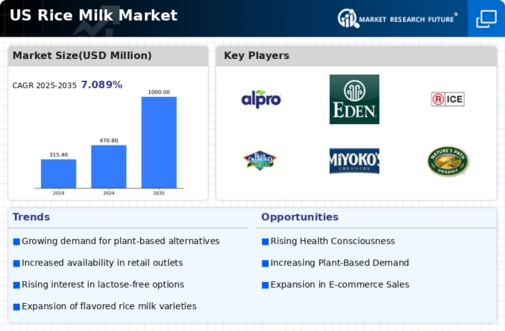Innovative Product Development
Innovation in product development within the rice milk market is becoming increasingly vital. Manufacturers are introducing a variety of flavors and formulations, such as fortified rice milk with added vitamins and minerals, to cater to diverse consumer preferences. This innovation not only attracts health-conscious consumers but also appeals to those seeking unique taste experiences. The introduction of organic and non-GMO rice milk options has also gained traction, reflecting a shift towards cleaner labels. As a result, the rice milk market is projected to grow, with innovative products likely contributing to an estimated increase in market value by 15% over the next few years.
Health Benefits and Nutritional Value
The perceived health benefits and nutritional value of rice milk are influencing consumer choices in the rice milk market. Rice milk is often viewed as a low-fat, low-calorie alternative to dairy, appealing to those seeking healthier lifestyle options. Additionally, it is naturally free from cholesterol and lactose, making it suitable for a wide range of dietary needs. Recent studies suggest that fortified rice milk can provide essential nutrients, such as calcium and vitamin D, which are crucial for bone health. As consumers become more informed about nutrition, the rice milk market is likely to see an uptick in demand, potentially increasing its market share by 12% in the near future.
Rising Veganism and Plant-Based Diets
The increasing adoption of veganism and plant-based diets in the US appears to be a significant driver for the rice milk market. As consumers become more health-conscious and environmentally aware, they are seeking alternatives to dairy products. Rice milk, being a plant-based option, aligns well with these dietary preferences. According to recent data, the plant-based milk segment has seen a growth rate of approximately 20% annually, with rice milk capturing a notable share. This trend suggests that the rice milk market is likely to expand as more individuals transition to vegan diets, further enhancing the demand for rice milk products.
Growing Awareness of Lactose Intolerance
The rising awareness of lactose intolerance among the US population is driving demand for lactose-free alternatives, including rice milk. Many individuals who experience discomfort with dairy products are turning to rice milk as a suitable substitute. This trend is particularly pronounced among younger consumers, who are more likely to seek out dairy alternatives. The rice milk market is benefiting from this shift, as it provides a palatable option for those avoiding lactose. Current estimates suggest that approximately 65% of the global population has some degree of lactose intolerance, indicating a substantial potential market for rice milk in the US.
Increased Availability in Retail Channels
The expansion of retail channels for rice milk products is a crucial driver for the rice milk market. Supermarkets, health food stores, and online platforms are increasingly stocking a variety of rice milk brands, making it more accessible to consumers. This increased availability is likely to enhance consumer awareness and encourage trial purchases. Data indicates that online sales of plant-based milk, including rice milk, have surged by 30% in recent years, reflecting changing shopping habits. As more consumers discover rice milk through various retail avenues, the market is expected to experience sustained growth, potentially leading to a market value increase of 10% in the coming years.






















Leave a Comment